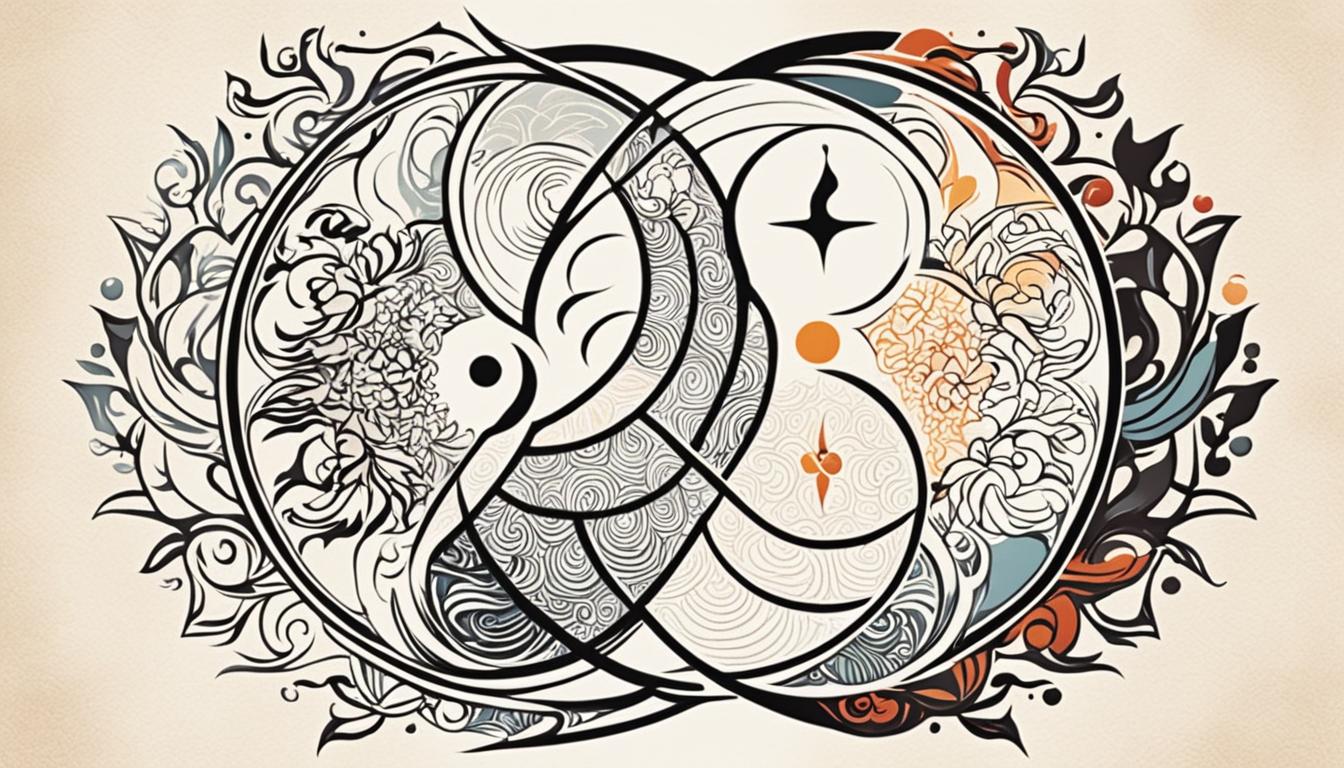Have you ever wondered if there is a path that can help you navigate the complexities of life with balance and harmony? A path that avoids the extremes of self-denial and indulgence? Buddhism offers an intriguing concept known as the Middle Way, which challenges our conventional beliefs and offers a unique perspective on finding enlightenment.
- The Middle Way in Buddhism refers to a path of moderation and balance advocated by the Buddha.
- It is a middle path between extreme asceticism and sensual indulgence.
- The Middle Way is associated with the Noble Eightfold Path, which includes right understanding, right thought, right speech, right action, right livelihood, right effort, right mindfulness, and right concentration.
- The Middle Way encourages practitioners to find the optimal balance in all aspects of life to achieve a state of inner peace and wisdom.
- It is a practical and philosophical concept that emphasizes interconnectedness and non-attachment.
Takeaways>
The Historical Context of the Middle Way
The concept of the middle way in Buddhism has its roots in the historical context of ancient India during the time of the Buddha. It was a period of great religious exploration and experimentation, with seekers of truth and liberation traversing various paths in pursuit of spiritual fulfillment and freedom from the suffering of life.
The Buddha’s Journey:
The Buddha, originally known as Prince Siddhartha Gautama, was born into a life of luxury and privilege. However, he became aware of the inherent suffering and impermanence of existence, igniting a deep desire within him to seek a way out of this cycle of dissatisfaction.
To pursue spiritual awakening, the Buddha first embarked on a path of extreme asceticism. He devoted himself to severe austerities and self-mortification, believing that the renunciation of worldly pleasures and physical pain would lead him to enlightenment.
After years of rigorous practice, the Buddha realized that such extreme measures did not bring him any closer to his goal. He recognized the inherent dangers of both extreme self-indulgence and severe self-mortification. It was then that he embraced a more moderate approach, the middle way.

The Middle Way Defined:
The middle way, also known as the middle path, is a philosophy and practice that rejects the extremes of self-indulgence and self-mortification. It advocates for finding a balanced and harmonious approach to life’s challenges, cultivating a state of equilibrium and clarity.
| Extreme self-indulgence | Middle Way | Extreme self-mortification |
|---|---|---|
| Excessive attachment to sensual pleasures | Balance between indulgence and renunciation | Severe physical austerity and deprivation |
| Lack of restraint and discipline | Moderation and mindfulness | Suffering due to extreme deprivation |
The Buddha’s Discovery:
Through his own experiences and introspection, the Buddha discovered that the middle way was the path to awakening and enlightenment. He realized that true liberation lies in neither extreme indulgence nor extreme asceticism, but in finding a balanced approach that fosters inner peace and wisdom.
The Buddha subsequently shared his insights and teachings on the middle way, guiding others towards a life of mindful awareness and compassionate action.
By following the middle path, practitioners strive to cultivate virtues such as right understanding, right thought, right speech, right action, right livelihood, right effort, right mindfulness, and right concentration. These principles form the Noble Eightfold Path and provide a roadmap for living a meaningful and fulfilling life.
The Middle Way in Practice
Practicing the middle way goes beyond mere moderation. It requires introspection and discernment, allowing individuals to navigate the complexities of life with wisdom and compassion.
- Recognizing the impermanence and interconnectedness of all phenomena.
- Cultivating mindfulness to observe and understand one’s thoughts, emotions, and actions.
- Fostering compassion and kindness towards oneself and others.
- Striving for a balanced approach to material possessions and desires.
- Embracing ethical conduct and moral principles.
The middle way encourages practitioners to find a balance between the demands of the material world and the pursuit of spiritual growth. It reminds individuals to avoid clinging to extremes and to embrace a flexible and wise perspective on life.
Next, we’ll explore how the middle way extends beyond being a practical path and becomes a profound philosophical concept in Buddhism.
The Middle Way as a Philosophical Concept
The middle way in Buddhism is not only a practical path of moderation, but it is also a profound philosophical concept that applies to various dualistic ideas. It encourages practitioners to find a balanced perspective in all aspects of life and embrace the dynamic and interconnected nature of existence.
One of the key applications of the middle way is in navigating opposing pairs such as subject/object, samsara/nirvana, and part/whole. By recognizing that these concepts exist on a continuum, practitioners can transcend the limitations imposed by rigid extremes and discover a more fluid and flexible approach.
The Madhyamaka school, founded by the esteemed philosopher-monk Nagarjuna, is an embodiment of the middle way. Its very name, Madhyamaka, is derived from the Sanskrit term for middle path, madhyama-pratipad. Nagarjuna applied the middle way to the concept of existence and nonexistence, arguing that emptiness (sunyata) lies in between any two opposites. This insight reveals that reality is not fixed or static, but rather characterized by possibility and creative potential.
Examples of the Middle Way in Buddhism
Let’s explore a few examples that illustrate how the middle way manifests in Buddhism:
- Subject/Object: The middle way challenges the dualistic perception of a separate self and the external world. Instead of getting caught up in the illusion of a solid self and others, practitioners are encouraged to see the interdependence and interconnectedness of all beings.
- Samsara/Nirvana: The middle way rejects the extremes of getting entangled in the cycle of suffering (samsara) or seeking permanent bliss (nirvana). Instead, it embraces the interplay between the two and recognizes that liberation can be found in the midst of ordinary existence.
- Part/Whole: The middle way encourages a holistic perspective that acknowledges the interconnectedness of all phenomena. Rather than dividing reality into isolated parts, practitioners strive to see the interdependence and unity of the whole.
By incorporating the middle way into their spiritual practice and everyday lives, Buddhists seek to cultivate a balanced, compassionate, and wise approach to existence.

The Middle Way and Dependent Origination
One of the crucial teachings of the middle way in Buddhism is dependent origination (pratityasamutpada), which illustrates the interconnected nature of all phenomena. It emphasizes that everything arises and ceases due to causes and conditions. The middle way rejects the extremes of eternalism, advocating for a permanent self or substance, and annihilationism, denying any continuity or existence beyond death.
Instead, the middle way offers a view that recognizes the impermanent and contingent nature of existence, without falling into the trap of nihilism. It highlights the absence of a fixed and independent self, which does not imply nothingness but rather emphasizes the interdependent and ever-changing nature of reality.
This teaching helps practitioners cultivate a deeper understanding of the true nature of phenomena. By embracing the middle way, you develop a non-attached and compassionate attitude towards life, recognizing the interconnectedness of all beings and the impermanence of all things.
Stay open to the dynamic flow of existence, understanding that everything arises and ceases, and that your experiences and actions are influenced by causes and conditions. This understanding can lead to a greater sense of freedom, letting go of attachments and finding inner peace in the ever-changing nature of reality.

Dependent Origination in Practice
Dependent origination can be seen in various aspects of our lives. Here are a few examples:
- The food we eat depends on the efforts of farmers, the weather, and the conditions for cultivation.
- The relationships we build depend on mutual understanding, communication, and shared experiences.
- The success we achieve in our careers depends on our determination, skills, and the opportunities we encounter.
Recognizing the interdependent nature of phenomena can help us develop gratitude, compassion, and empathy towards others. It can also lead to a deeper recognition of our own role in contributing to the well-being of others and the world around us.
Conclusion
The middle way in Buddhism offers a valuable and practical approach to navigating the challenges of life. By embracing the middle path, you can find a balance between extremes and cultivate mindfulness, compassion, and wisdom.
The middle way is not about striving for perfection or absolute certainty. Instead, it encourages you to embrace the dynamic and interconnected nature of existence. It invites you to let go of rigid extremes and find a state of peace and understanding in the present moment.
Through the middle way, you can avoid the pitfalls of extreme asceticism or indulgence. This path leads to personal and societal harmony and offers insights for achieving true enlightenment. By walking the middle way, you can discover a transformative journey that brings clarity, joy, and purpose to your life.

